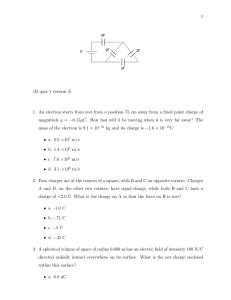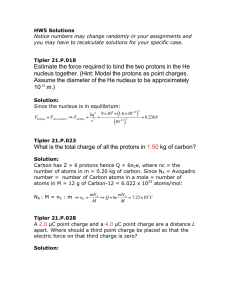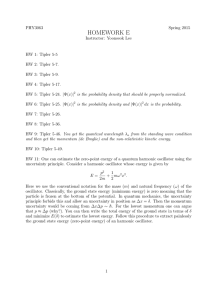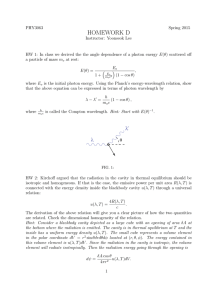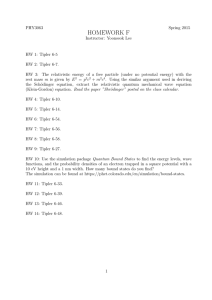The figure below shows a portion of an infinitely long, concentric
advertisement
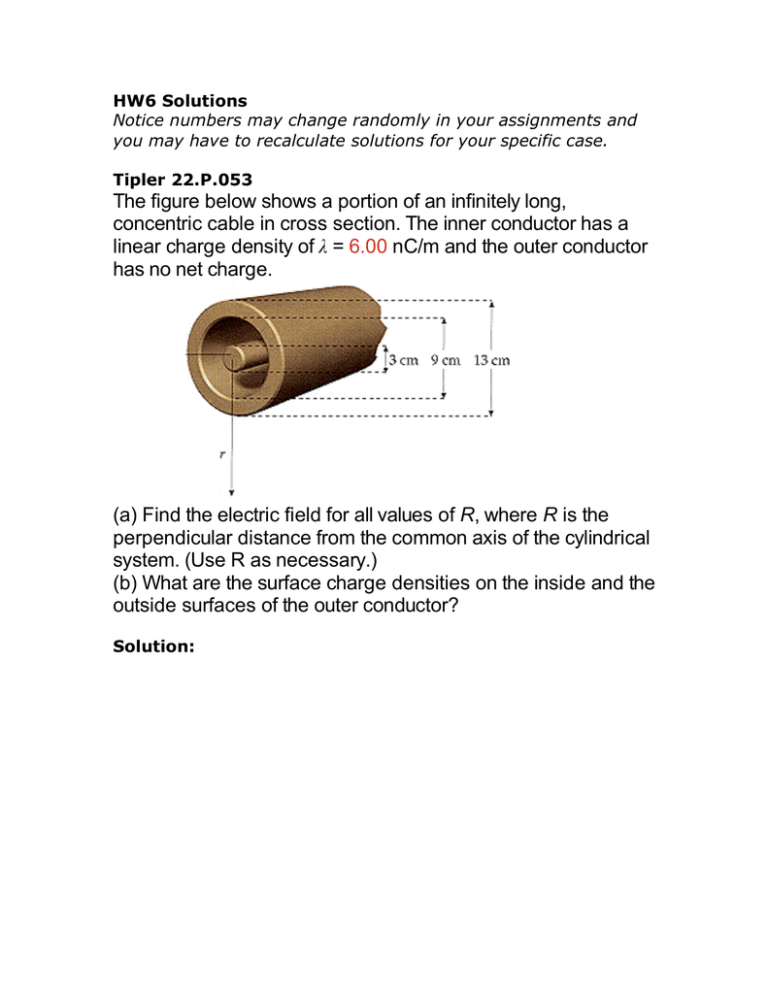
HW6 Solutions Notice numbers may change randomly in your assignments and you may have to recalculate solutions for your specific case. Tipler 22.P.053 The figure below shows a portion of an infinitely long, concentric cable in cross section. The inner conductor has a linear charge density of λ = 6.00 nC/m and the outer conductor has no net charge. (a) Find the electric field for all values of R, where R is the perpendicular distance from the common axis of the cylindrical system. (Use R as necessary.) (b) What are the surface charge densities on the inside and the outside surfaces of the outer conductor? Solution: Tipler 22.P.071 Two identical square parallel metal plates each have an area of 500 cm2. They are separated by 1.50 cm. They are both initially uncharged. Now a charge of +1.50 nC is transferred from the plate on the left to the plate on the right and the charges then establish electrostatic equilibrium. (Neglect edge effects.) (a) What is the electric field between the plates at a distance of 0.25 cm from the plate on the right? (b) What is the electric field between the plates a distance of 1.00 cm from the plate on the left? (c) What is the electric field just to the left of the plate on the left? (d) What is the electric field just to the right of the plate on the right? Solution: The left plate has negative charge -1.50 nC and the right one has positive charge + 1.50 nC. The field due to each surface charge distribution can be calculated by the Gauss’ law applied to a cylinder that crosses each plane. For each plane: ES+ES = σS/ε0 E = σ/2ε0 + The field for the 2 plates sums inside the 2 plates and cancels outside. (a) and (b) the field is uniform inside the plates so any point the value is: E= ! in-- + + + + + + + + " Q /S 1.50 $10%9 = = = 3.39kN /C #0 #0 8.85 $10%12 $ 500 $10%4 (c) and (d) outside plates the fields due to the 2 plates cancel and the field is zero. Tipler 22.P.076 A nonconducting sphere 1.20 m in diameter with its center on the x axis at x = 4.00 m carries a uniform volume charge of density ρ = +5.00 µC/m3. Surrounding the sphere is a spherical (thin) shell with a diameter of 2.40 m and a uniform surface charge density σ = -1.50 µC/m2. Calculate the magnitude and direction of the electric field at the following locations. (a) x = 4.50 m, y = 0 (point 1 in the figure) (b) x = 4.00 m, y = 1.10 m (point 2) (c) x = 2.00 m, y = 3.00 m (point 3) Solution: the angle respect to the x-axis of the E-field. Tipler 23.P.019 A point particle has a charge equal to +2.00 µC and is fixed at the origin. (a) What is the electric potentialV at a point 4.00 m from the origin assuming that V = 0 at infinity? (b) How much work must be done to bring a second point particle that has a charge of +3.00 µC from the infinity to a distance of 4.00 m from the +2.00-µC charge? Solution: Tipler 23.P.020 Two facing surfaces of two large parallel conducting plates separated by 10.0 cm have uniform surface charge densities such that are equal in magnitude but opposite in sign. The difference in potential between the plates is 500.0 V. (a) Is the positive or the negative plate at the higher potential? (b) What is the magnitude of the electric field between the plates? (c) An electron is released from rest next to the negatively charged surface. Find the work done by the electric field on the electron as the electron moves from the release point to the positive plate. Express your answer in both electron volts and joules. (d) What is the change in potential energy of the electron when it moves from the release point to the positive plate? (e) What is its kinetic energy when it reaches the positive plate? Solution: Tipler 23.P.036 r 3 An electric field is given by E x = bx iˆ , where b = 2.00 kV/m4. Find the potential difference between the points on the x axis at x = 1.00 m and x = 2.00 m. Solution: ! Tipler 23.P.048 The electric potential at the surface of a uniformly charged sphere is 450.0 V. At a point outside the sphere at a (radial) distance of 20.0 cm from its surface, the electric potential is 150.0 V. (The potential is zero very far from the sphere.) What is the radius of the sphere, and what is the charge of the sphere? Solution: Tipler 23.P.079 A positive point charge +Q is located on the x axis at x = -a. (a) How much work is required to bring an identical point charge from infinity to the point on the x axis at x = +a? (Use k, a, and Q as necessary.) (b) With the two identical point charges in place at x = -a and x = +a, how much work is required to bring a third charge -Q from infinity to the origin? (Use k, a, and Q as necessary.) (c) How much work is required to move the charge -Q from the origin to the point on the x axis at x = 2a along the semicircular path shown? (Use k, a, and Q as necessary.) Solution: Tipler 23.P.040 A charge of q = +10.0 µC is uniformly distributed on a spherical shell of radius 12.0 cm. (a) What is the magnitude of the electric field just outside and just inside the shell? (b) What is the magnitude of the electric potential just outside and just inside the shell? (c) What is the electric potential at the center of the shell? (d) What is the electric field at that point? Solution: Tipler 23.P.054 A disk of radius R has a surface charge distribution given by σ = σ0 R/r where σ0 is a constant and r is the distance from the center of the disk. (Use pi for π, R for R, k for k, x for x, and sigma_0 for σ0, as necessary.) (a) Find the total charge on the disk. (b) Find an expression for the electric potential at a distance x from the center of the disk on the axis that passes through the disk's center and is perpendicular to its plane. Solution: Tipler 23.P.060 An infinite plane of charge has surface charge density 0.5 µC/m2. How far apart are the equipotential surfaces whose potentials differ by 100 V? Solution: Tipler 23.P.068 Four point charges, each having a charge with a magnitude of 2.00 µC, are at the corners of a square whose sides are 4.00 m long. Find the electrostatic potential energy of this system under the following conditions. (a) all of the charges are negative; (b) three of the charges are positive and one of the charges is negative; (c) the charges at two adjacent corners are positive and the other two charges are negative (d) the charges at two opposite corners are positive and the other two charges are negative (Assume the potential energy is zero when the point charges are very far from each other.) Solution: Tipler 23.P.042 (a) Find the maximum net charge that can be placed on a spherical conductor of radius 16 cm before dielectric breakdown of the air occurs. (b) What is the potential of the sphere when it carries this maximum charge? Solution: Tipler 23.P.058 Calculate the electric potential at the point a distance R/2 from the center of a uniformly charged thin spherical shell of radius R and charge Q. Assume the potential is zero far from the shell. (Use k, R and Q as necessary.) Solution: Tipler 23.P.078 Solution:

